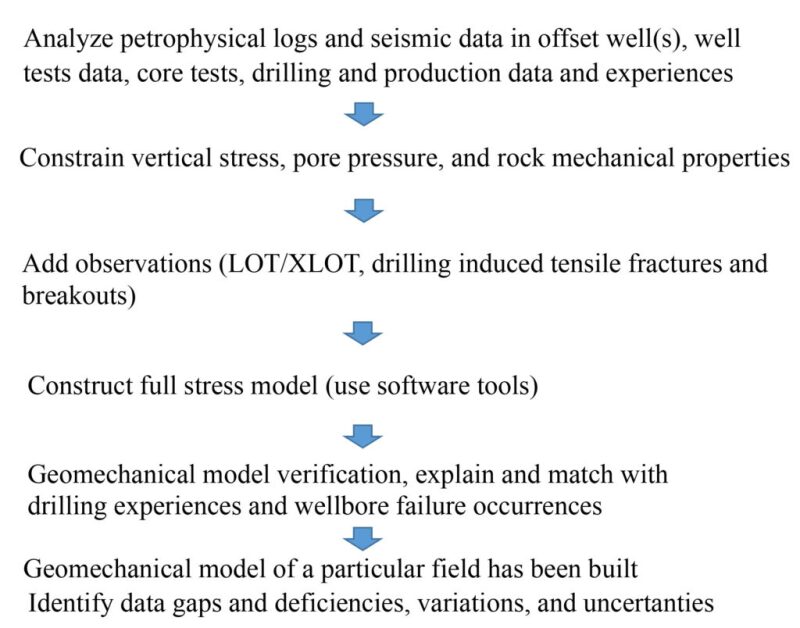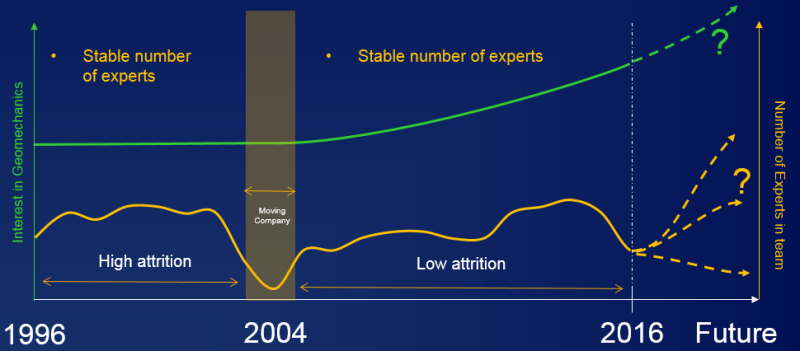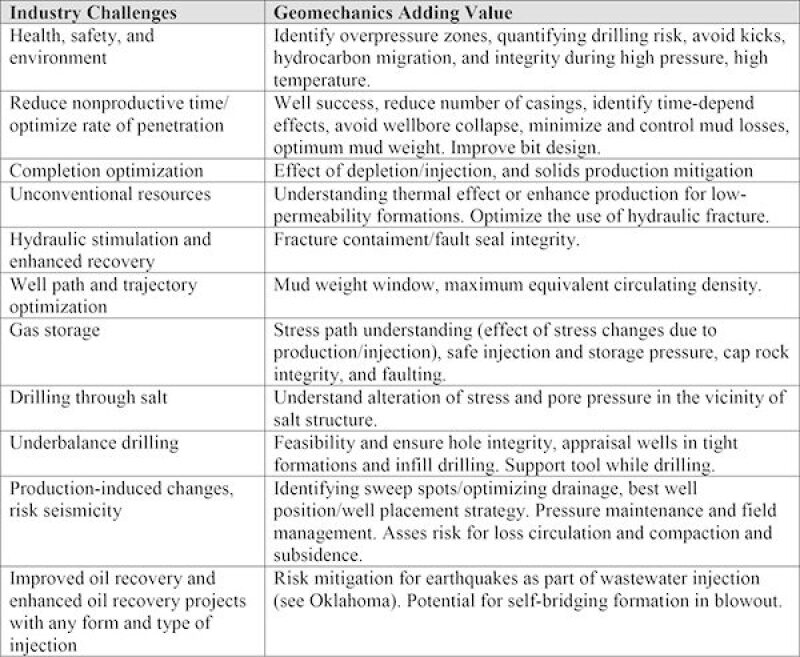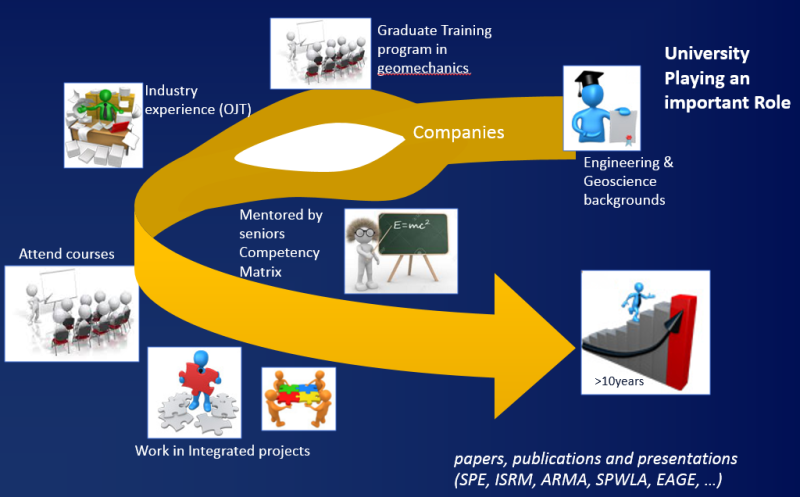Geomechanics received attention in the mainstream petroleum industry in the late 1990s due to newer and better modeling techniques leading to far better drilling and production outcomes. However, that acceptance may be at risk due to a widening knowledge gap. There is a significant and growing gap between the knowledge that trained and experienced geomechanics experts bring to the industry and the knowledge of professionals trying to enter or re-enter the geomechanics discipline. As a result, there is a potential risk of missing out on the opportunity to transfer significant know-how such as how to properly conduct geomechanical analyses and how to approach field challenges. Therefore, passing the baton to a younger generation of geomechanics professionals is critical, since the evolving discipline will need to maintain or even increase its contribution to the industry as part of field or resevoir life-cycle optimization in the years to come. With the current reduced industry activity this valuable contribution is threatened.
Any geomechanics-related problem identified during the exporation stage is key. This is because a comprehensive understanding of the rock mechanical behavior in response to the evolving earth stresses over the life of the field will have the greatest impact when recognized early. Thus, acquiring data, such as cores or geophysical logs in the subsurface formations at the exploration and appraisal stage is necessary and knowing what to do with it is especially important. Continuing to give geomechanics credit as an important discipline will ensure that the next generation of professionals in the geomechanics community can contribute value during all stages of field development.
Geomechanics at a Glance
Geomechanics is defined as the interaction between the present-day in-situ stresses and rock mechanical properties. Rock failures caused by this interaction are the focus of most geomechanical studies, whether in the reservoir or overburden and whether during exploration, abandonment, or any field operation in between.
An examination of the earliest publications related to geomechanics and the number of geomechanics contacts in the business-oriented social networking service Linkedln indicates that geomechanics is a relatively new discipline compared to drilling engineering, reservoir engineering, rock mechanics, or petrophysics. However, the contribution of geomechanics has increased appreciably over the last 15 years.
One of the earliest studies in geomechanics dates from 1979; the study was published by Bradley (1979) in the Journal of Energy Resources where he developed a model to calculate the in-situ stress in an arbitrarily oriented hole. Previous to this, a book dedicated to the study of rock mechanics was published—the first edition of Fundamentals of Rock Mechanics, by Jaeger and Cook in 1969. The fourth edition of the book by Jaeger, Cook, and Zimmerman (published in 2007) is a good reference book for the oil industry. In 1992, a book dedicated to the study of geomechanics applied to oil industry called the Petroleum Related Rock Mechanics was published (Fjaer et al. 1992).
A search of the number of members that are registered in Linkedln indicated that at least 10,163 contacts have listed geomechanics as one of their skills as of 21 March 2016. Only 13% of these people have more than 20 years of industry experience illustrating that only a small number of experienced professionals exist in this field compared with a relatively large pool of young professionals.
Geomechanical Model and Its Value
The geomechanical model is described when at least five key parameters are constrained in a given volume of the Earth’s crust. They are the three principal in-situ stresses (orientations and magnitudes), the rock mechanical properties, and the pore pressure distribution.
The geomechancial behavior of wells drilled in reservoirs is not always consistent. One must know that a reservoir rock successfully drilled vertically (i.e., trouble-free reaching total depth) has no guarantee of the same success if there is a change in the well trajectory (inclination/azimuth) or even the well location. This reality introduces the importance of knowing how reliable geomechanical models and well planning strongly influence decisions that are transformed into proper well construction, risk mitigation, and cost reductions.
A reliable and robust geomechanical model requires a variety of data from different sources, including seismic, well log data, core, drilling and production data, and field measurements. Due to the abundance of data sources, a geomechanics specialist must be able to extract and interpret key information from drilling and completion reports, laboratory core tests data, well logs including borehole image data, and well test data such as leak off test (LOT)/minifrac tests or formation pressure tests. In addition, he or she must have an adequate understanding of pore pressure generation and retention mechanisms as well as structural geology of the field, including the reservoir sections and the surrounding formations studied. This interdisciplinary understanding is necessary to select the appropriate modeling technique for solving key challenges for well delivery and reservoir development. A critical requirement for any geomechanical analysis that must not be omitted is a careful assessment of parameter uncertanties and natural variabilities as well as their effects on the study results.
Below is an overview of steps required to construct a geomechanical model and what usually is captured and adequately explained in any geomechanical report (Fig.1).

Problem Identification and Experience
In the current market where oil price weakness has significantly reduced investment, the resultant reduction in capital expenditure and operational expenditure has had a substantial impact on the labor force in the oil industry. Many jobs have been lost and numerous redundancies have occurred across the industry and in all disciplines, including geomechanics.
This situation suggests that the number of geomechanics experts will fall or at best remain at current levels with no additional resources added to the geomechanics workforce for a period of time. Worse yet, the number of experts may fall further in the coming years as a consequence of those who change career paths due to redundancy or a shortage of employment opportunities. However, when activity levels increase, I expect the interest in geomechanics will grow, especially with new technology developments in geomechanics such as 3D–4D modeling, which makes the subject an even more attractive prospect for recent graduates. This increased interest will raise the training and mentoring workload for the remaining experienced experts in the future. Thus, the consequences of a future lack of expertise are significant, where geomechanical concepts and practices can be misunderstood and mishandleded by inexperienced geomechanics practitioners.
Only geomechanics experts with experience and exposure to a variety of situations are capable of dealing with the uncertanties that data acquisition, modeling, and results generate. These are the experts who can deliver reasonable modeling results and ensure the right approach is chosen when difficult decisions need to be made, such as assessing challenging operational environments. This is important for a variety of situations and applications such as mud weight selection when faced with narrow mud windows or overpressured zones; drilling infill wells into heavily pressure depleted formations; production and completion optimization with adequate sand management to mitigate production risks, reservoir compaction, well integrity issues, safety and potential enviromental risks associated with fluid leakage and production or injection induced seismicity.

Figure 2 illustrates my experience as a geomechanics specialist—within the team I have been working—since joining the oil industry in 1997. In the early years of my career, I did not perceive a noticeable increase in the interest in geomechanics, which I assumed was because geomechanics could not demonstrate its value or relevance, despite extensive, global subsurface operations. Based on people movements within my team, the number of people specializing in geomechanics did not increase throughout the period between 1996 and 2004. This period was characterized by high attrition of experts, balanced by new experts joining the geomechanics community. The high attrition was a consequence of the following: i) many companies were acquiring their own geomechanics expertise and they were hiring, ii) many (small) geomechanics companies came into existence, and iii) bigger service companies started developing their geomechanics expertise and groups.
From 2005 to the end of 2015, the interest in geomechanics increased, while the number of experts slightly increased but only after 2010. During the past 6–7 years, the number of geomechanics-related studies increased markedly throughout the industry. This enabled the community to gain, apply, and transfer the knowledge acquired to many young professionals who had joined the respective geomechanics teams in a given company. Low attrition was observed, mainly due to the fact that geomechanics was recognized as a discipline with development programs and opportunities for career advancement, predominantly in major oil companies.
When the current cycle turns I expect the trend for those interested in geomechanics will continue to rise, but the inherent uncertainties make it difficult to predict how exactly this trend will develop in the industry. I only hope that economic recovery begins soon, enabling interest and the number of experts to continue to gradually increase.
Value of Geomechanics and Its Application
The life cycle of an oil field goes from exploration to appraisal and development stages, to rejuvenation and ultimately abandoment. If geomechanics becomes part of the very early stage of the field life cycle, it ensures that many of the typical near-wellbore and reservoirwide issues over a reservoir’s life can be understood, predicted, and avoided. Early identification of the geomechanics-related problems is required to optimally drill, complete, stimulate, and produce from the reservoirs. Furthermore, the window of opportunity to acquire the necessary data that enable construction of robust geomechanical models generally exists in the early stage of the field life. This opportunity needs to be seized if geomechanical challenges are to be identified and the full value that geomechanics can bring in understanting and mitigating the risks are to be recognized, with the resultant increase in productivity and a reduction of costs.
Geomechanics teams do exist within mid-to-large-sized oil companies; however, in the majority of these cases, the geomechanics discipline does not appear to have a standard “home” in the organizational structure. Across the industry in service and operating companies, geomechanics as a discipline tends to be added to disciplines like geology, petrophysics, or drilling. This has advantages because it leads to integration and collaboration between the different disciplines. However, the more severe problem is that this setup does not confer to geomechanics the optimum level of influence in a company’s decision-making process. It is imperative that geomechanical evaluation is seen as a valued and necesary input to the decision-making processes, for this it needs to be established as a standalone technical discipline.
Furthermore, geomechanics as a discipline should have a defined development program and career path to retain talent. Over the years, the discipline has proved itself as a significant contributer to drilling, completion, production, and injection operations. More recently, its contribution to hydrocarbon recoveries from unconventional resources, in geothermal, gas storage, waste disposal, and CO2 sequestration projects has been recognized.
Three specific examples of recognition of the importance of geomechanics:
- Dan Moos (Baker Hughes Fellow) mentioned during his SPE lecture in 2014 that “all disciplines will need a fundamental understanding of geomechanics.”
- Kurt Wikel at Petrobank Energy and Resources, responsible for subsurface Geophysics and Geomechanics, mentioned in his article (2011) “Geomechanics: Bridging the Gap from Geophysics to Engineering in Unconventional Reservoirs,” that “in hydraulic fracturing projects geomechanics dictates how our subsurface formations fail, the direction of and the extent of the hydraulic stimulations, position of your wellbore, the size and strength of proppant, by quantifying stresses and rock properties.”
- John Cook (Schlumberger geomechanics advisor), indicated in an Oilfield Review article in 2015 that geomechanics “is crucial in improving efficiency and driving drilling cost down.”
The typical industry challenges where geomechanics can be an influencer are listed in Table 1.

Passing the Baton: My Two Cents
Workflows to build geomechanical models are well established in many oil companies. It does not really matter how a geomechanical model has been built, as long as it follows a comprehensive workflow and the model is consistent with field and subsurface data, and drilling and production experiences.
In recent years, academia and industry have undertaken appreciable efforts to form specialized groups with the aim of providing guidelines for best practices and tackling real-life challenges. However, to further increase the value of geomechanics and its level of importance among other disciplines, three key players must exist: academic institutes and the oil industry, with an additional contribution from professional societies.
Academia. At a very early stage or when students are deciding which subjects to choose, the responsibility lies with universities. Universities should not only offer geomechanics lectures, but should promote dedicated educational programs on geomechanics and its application in the petroleum industry.
Oil industry. For new graduates joining any geomechanics group, the role of companies is to offer at entry level a graduate training program with geomechanics as a main subject. Intern programs are also recommended. To reduce the risk of attrition, companies should offer a competency matrix for geoscientists and engineers, cross-discipline interaction with multidisciplinary team to maximize its application (i.e., production technologist, geologist, completion and drilling engineers, etc.), and offer mentoring or on-the-job training schemes where experts in geomechanics should be actively involved.
Professional societies. For professional societies like SPE, European Association of Geoscientists and Engineers, American Association of Petroleum Geologists, Society of Exploration Geophysicists, Society of Petrophysicists and Well Log Analysts, American Rock Mechanics Association, and International Society for Rock Mechanics, there needs to be an increased attention to education in geomechanics. Thus, it is important to consider standardizing workflows, similar to those that already exist for rock mechanical tests; for example, strategies for constraining geomechanics parameters to ensure the basics are followed.

Conclusions
Over the last 20 years, it has been proven that geomechanics adds value in solving industry challenges and mitigating risks helping optimize field development. Early inclusion of geomechanics into field development plans ensures that the results are used in a timely manner for critical field management decisions, e.g., optimizing casing designs, well trajectories, completion, and production. Therefore, it is imperative that geomechanics is recognized as a discipline with similar authority and relevance as other subsurface and well engineering disciplines. This would enable geomechanics to advance from a reactive after-thought to a progressive active player, implementing its value early on in field development and throughout the life of the field.
I foresee that there will remain a need to ensure adequate training and mentoring of young professionals, whether in-house or by attending external workshops/conferences. Thus, universities and oil companies should provide adequate resources to this discipline. It is important that growth is maintained with regards to education and retaining senior staff members. Working with the younger generation of professionals, there is a responsibility for oil companies, professional leaders, including geomechanics experts, to emphasize the value of geomechanics studies in industry projects with the aim of recognizing geomechanics as an important discipline.
My message to the young professionals eager to become experts is to keep their interest, as this will ensure unique opportunities to get involved in geomechanics which is an evolving discipline with a vast potential to grow for many years ahead.
References
Bradley W. B. 1979. J. Energy Resour. Technol 101(4): 232–239.
Cook, J. 2015. Geomechanics. The Defining Series. Oilfield Review.
Fjaer et al. 1992. Petroleum Related Rock Mechanics, first edition. Elsevier.
Jaeger, J.C. and Cook, N.G.W. 1969. Fundamental of Rock Mechanics, first edition. London: Methuen.
Jaeger, J.C., Cook, N.G.W., and Zimmerman, R.W. 2007. Fundamental of Rock Mechanics, fourth edition. Blackwell Publishing.
Wikel, K. 2011. Geomechanics: Bridging the Gap From Geophysics to Engineering in Unconventional Reservoirs. First Break, 29(10): 71–80.
Acknowledgements
To my mentors Thomas Finkbeiner (King Abdullah University of Science and Technology), Abbas Khaksar (Baker Hughes), and Nicolás Galíndez (Repsol). Also, thanks to the team I belonged to at Baker Hughes; their comments and helpful discussions were very much appreciated.


